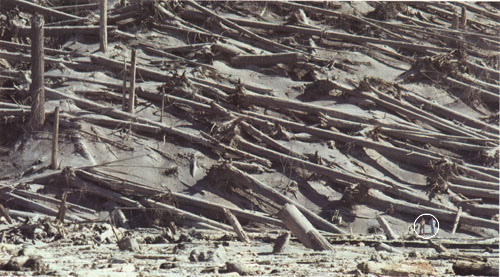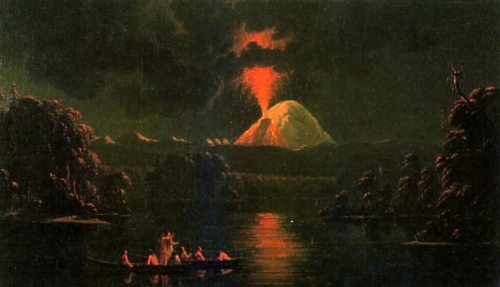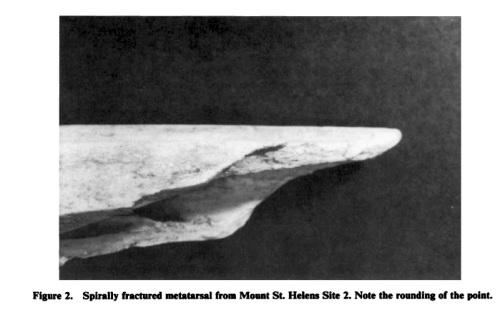Today is the 30th anniversary of the cataclysmic eruption of Mount St. Helens, an explosion so large that it could be heard as far north as southern Vancouver Island. The mountain has erupted many times in the past – one of which was captured by the well known painter Paul Kane (above) – and will continue to erupt indefinitely. Many of these eruptions and its fickle nature loom large in oral histories. The ash from prior eruptions forms important geological marker horizons all over the Northwest. Judging by this map, there are no known obsidian sources directly associated with Mount St Helens. These are the more obvious kinds of connections to archaeology and they shouldn’t be discounted. Another approach exemplifies a kind of morbidly creative lateral thinking.

Flattened and sheared trees near Mount St. Helens. Note humans, lower right, for scale. Source: USGS
The 1980 blast killed thousands of deer and elk, and their bodies were subjected to the same enormous forces which flattened the forest, being hurled large distances and smashed against bedrock, volcanic ejecta and downed trees. Too bad for these cervids, but a nice natural laboratory for the study of bone breakage patterns. Dr. R. Lee Lyman, now at University of Missouri, took advantage of some of the natural death assemblages and recovered a number of recently dead cervid skeletons. He found a number of the bones, which unequivocally had not been butchered by humans or killed by predators in this apocalyptic context, showed modifications that were highly suggestive of human agency. Indeed, he suggests some of these pseudo-tools might well past muster by even quite discriminating archaeologists were they to be found in an archaeological site.
In the above picture, Lyman makes a case that the pointed part of the fractured bone shows wear and rounding that would be interpreted as use-wear by many archaeologists, but which he atrributes to contact with abrasive volcanic ash.
In the above and below, there is clear and quite distinctly localized patterns of micro-flaking along the presumptive working edge of the tool. Lyman attributes these to the extraordinary forces applied to the cervid carcasses, including torsion and twisting of broken bones and their impact against each other. And certainly these are convincing pseudo-tools.
But what is the lesson learned? In the big picture, it shows that extraordinary events can create the sorts of forces and results also created by a determined human with a stone chopping tool. When it is a sudden natural force, like a volcano, then these pseudo-tools may be subjected to a limited range of effects and therefore even more fully emulate expedient bone tools. Compare the result from St. Helens to, say, an elk carcass being washed down a river. In the latter, the carcass is exposed to a variety of natural forces that will probably dull many margins of broken bone, create chaotic fracture patterns, and eventually be exposed to organic degradations via bacteria, fish, rodents, etc.
The point is, the Mount St. Helens case study is an out of the ordinary event. If you are an archaeologist fooled by a bone pseudo-tool, and you missed the volcanic eruption, then there may be other reasons not to take you seriously. And to his credit, Lyman presents the material as an interesting cautionary tale, not as some kind of unwarranted argument that other bone tools from archaeological contexts should be doubted. He offers a useful model of bone reduction and some good observations but these decontextualized pseudo-tools are an easy target – if they were found in an archaeological site with archaeological context and with no evidence of extraordinary geological forces, then yes, they probably would be classed as artifacts and probably they would be. But if you want to find out more then luckily you can download a copy of his 1984 paper here, and a related 1989 publication (with very poor image qualities) here.
References:
Lyman, R. L. 1984. Broken Bones, Bone Expediency Tools, and Bone Pseudotools: Lessons from the Blast Zone Around Mt. St. Helens, Washington. American Antiquity. 49:315-33.
Lyman, R. L. 1989. Taphonomy of Cervids Killed by the 18 May 1980 Volcanic Eruption of Mount St. Helens, Washington, U.S.A. In Bone Modification, edited by R. Bonnichsen and M. Sorg, pp. 149–167. University of Maine Center for the Study of Early Man, Orono.






The great photojournalism blog “The Big Picture” has a good retrospective series on Mt St Helens today:
http://www.boston.com/bigpicture/2010/05/mount_st_helens_30_years_ago.html
This one of tree blowdown is particularly impressive:
http://www.boston.com/bigpicture/2010/05/mount_st_helens_30_years_ago.html#photo16
And of course the famous eruption sequence caught by Gary Rosenquist, as a series of still photo frames (these days there’d be 20 different high-def angles, of course):
http://video.google.com/videoplay?docid=3977416382972126736#
LikeLike
Love cautionary tales !!! As a neophyte, I was sucked into what, at the time, seemed to be a completely plausible artifact type – reworked historic glass. Excavating a number of historic sites out east (going back to the 1650’s and up into the late 1800’s), we frequently ran across broken glass that, for all purposes, appeared to have been utilized in the manner of lithics after breakage. Great-looking retouch in many cases, and more complex patterns than could be readily attributed to trampling or other taphonomic events. Primarily, if not exculasively, expedient tools though. And the logic was absolutely reasonable – why wouldn’t people be re-using what was, in those time periods, a scarce commodity ? Window glass appeared to be a preffered material for retouch, over, say, bottle glass. In the intervening years since, and having found many more pieces of glass with evidence of ‘retouch’ in the middle of cultivated fields while conducting transects, I’m not as convinced that this category of artifact is as ‘real’ as it seems. Undoubtedly some were bona-fide artifacts, but i have a sneaking suspicions that the ‘retouch’ we see on many historic sites isn’t a result of tool-use, or for those skeptics, trampling or impacts from plowing. I think it has much more to do with the physical nature and differential chemistry of the glass, and how it reacts to not only freeze-thaw cycles but micro-pressures from the clasts in its surrounding matrix after burial. While a great experiment in archaeological replication, I somehow sense that it would be difficult to find an archaeology student in this part of the world interested in exploring the taphonomy of historic glass … but what if it had implications for the formation of obsidian ecofacts ? While hard to argue that a piece of Edziza obsidian found in a solitary context in NE BC is an ecofact, one should consider to what extent any retouch it exhibits is anthropogenic, what isn’t. It could turn pieces of debitage into ‘tools’, thereby changing our perceptions of that site and our evaluation of its significance.
I think I digressed.
LikeLike
Hi Remi,
I think Ian Sellers, a current SFU graduate student, is going to be looking at glass artifacts from a site in Barkley Sound. It’s a good point that these need to be shown unequivocally to be the deliberate product of an intention to make tools.
I guess you know about Andrew Martindale and Irena Jurakic’s paper on expedient glass use in Tsimshian territory? They do try to address some of your concerns. It’s downloadable at:
Click to access Martindale_and_Jurakic_2006.pdf
LikeLike
Huh – well waddaknow ! Thanks for the link ! Great little paper.
LikeLike
Fascinating! But why do scientists stay up so late blogging?!
LikeLike
Ingeniously, they set the posts to appear in the middle of the night, so when the loyal readers wake up and check their email it is like Christmas, every day.
LikeLike